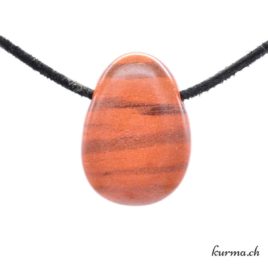Sandstone
gemstones in pendant necklaces
Soothing and stabilizing in lithotherapy, Sandstone is a rock produced by the aggregation of grains of sand, appreciated for its soft ochre hues and harmonious, fluid and surprising patterns.
What are the virtues and properties of sandstone in lithotherapy?
Its symbols
Sandstone was used to build lasting monuments in ancient times, such as the temples of Angkor in Cambodia. This sedimentary rock consists mainly of sand grains - silica and minerals.
Perhaps its slow formation and natural resistance are the origin of its symbols, linking it to resistance to the tests of time in lithotherapy, to stability and resilience, conferring protective properties against all negative energy.
Its benefits
Lithotherapy links the soothing and stabilizing properties of Sandstone with earth energy. The inner calm it promotes is the fruit of a serene anchoring of the emotions, reinforced by a now obvious connection with nature.
Reducing anxiety will stimulate clarity of mind and encourage balanced choices.
This sandy rock, with its surprising, sometimes landscape-like patterns - qualities often used in pottery - can be used to stimulate the imagination and creativity. Stoneware is an ally that carries the wisdom and memory of the earth. It invites you to consider and honor it in all its diversity.
Which stones to combine with sandstone for lithotherapy benefits?
- Red Jasper reinforces the stabilizing energy of Sandstone
- similarly, Obsidian will help anchor
- and Rose Quartz linked to gentleness and love for a feeling of both strength and calm.
How to purify sandstone
Clean / recharge
Under the Moon, running water, waveform, fumigation, singing bowl, wind/breath, prayers...Chakras
1st and 2ᵉ chakra - Root and SacralAstrological signs
Taurus, Virgo, CapricornFor and seeking stability and anchoring
Element
EarthThose and search of a connection with nature and their deepest essence
Sandstone mineralogy
Sandstone is a detrital sedimentary rock, composed mainly of quartz, which may contain feldspars and other mineral fragments, bound by silica or calcium carbonate.
It forms in sedimentary environments, such as deserts, riverbeds, beaches or seabeds, but also in other geological formations around the world.
Its color can vary according to the minerals present - from white to brown to red.
Its hardness depends on its composition - from crumbly to very compact.
Other stones with surprising designs
Reproduction in whole or in part of this content is prohibited. More info


